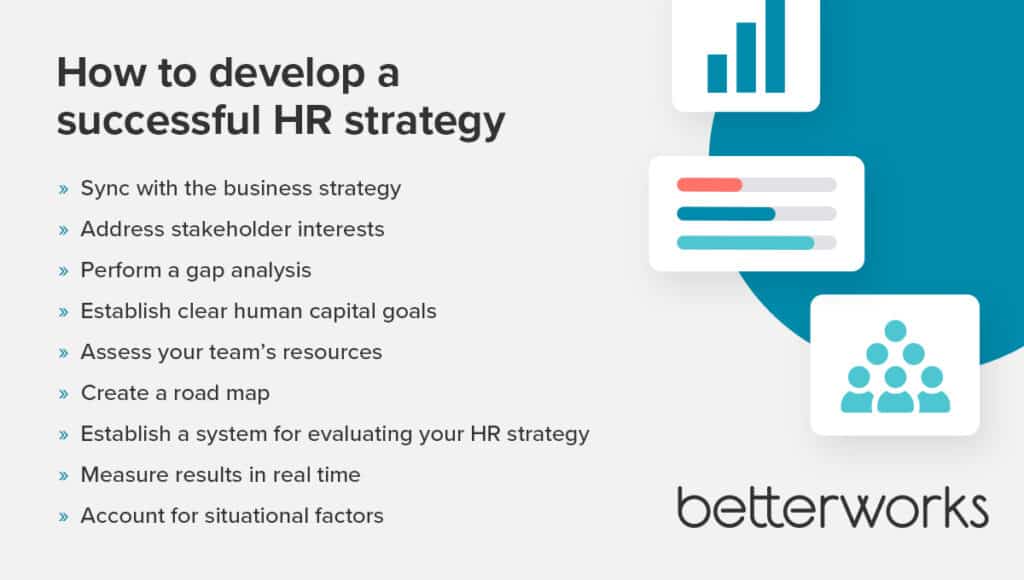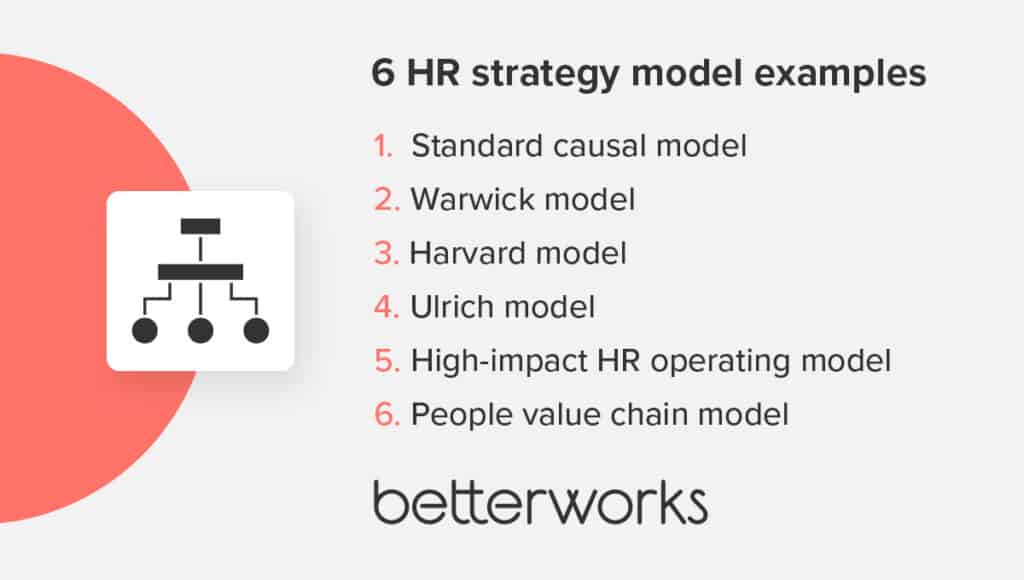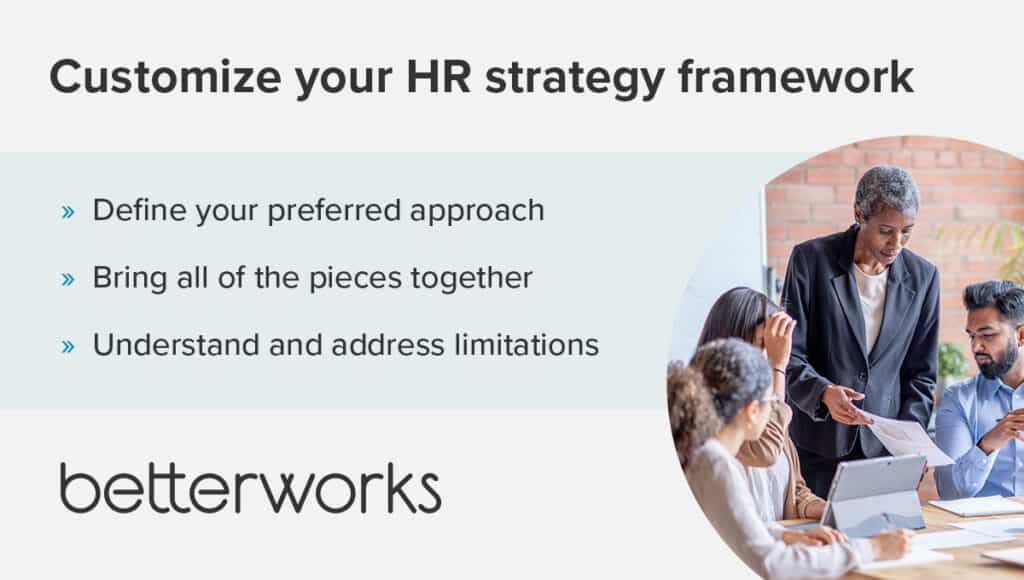No business model is complete without a comprehensive HR strategy. An effective people strategy guarantees that your organization has the right people with the right skills in the right roles to maximize competitive advantage.
But what goes into successful human resources strategies?
Your HR or people strategy is a road map providing direction for people policies, processes, and programs. It defines clear outcomes for overcoming business challenges using HR solutions and actions for achieving those desired outcomes. While stemming from the business strategy, your HR strategy’s primary goal is keeping all your HR functions aligned and pulling in the right direction.
Learn how to develop an HR strategy that drives your business forward.
Why HR strategy matters for your company
An effective HR strategy produces several important benefits for the business. Operationally, it pulls all your HR functions together — talent acquisition, retention, and succession planning. It also influences functions that fall under the HR umbrella, such as learning and development and diversity, equity, and inclusion.
A strong HR strategy is aligned with the business strategy, so both benefit from each other. And it guides purpose-driven actions so you can make the most of your resources.
For example, if business leaders want to reduce production time and expenses, an HR strategy would consider how each function affects that goal. Instead of simply reducing headcount, a company could cut labor costs at a factory by hiring more qualified manufacturing employees or providing better employee training. Alternatively, improving the employee experience could increase productivity and effectively reduce labor costs.
Every HR decision you make has tangible effects on the business. Your HR strategy harnesses that power to help you make targeted choices that drive business results.
How to develop a successful HR strategy
Effective HR strategies require thought and planning. The process starts with understanding what you hope to achieve and continues through multiple stages, including assessing HR programs and resources, implementing the strategy, and evaluating its impact.
Here are nine steps for developing an HR strategy at your organization.
Sync with the business strategy
Before you articulate the goals for your HR strategy, you should understand what the business is trying to do. Because HR is a shared service center, every decision you make affects the entire organization. If your people strategy isn’t helping the business, your impact is reduced — and maybe even counterproductive. But when HR is in sync with organizational priorities, you deliver outcomes that drive results.
Start with a strengths, weaknesses, opportunities, and threats (SWOT) analysis to clarify the business objectives and identify the internal and external factors that are favorable and unfavorable to achieving them. How can your HR strategy leverage organizational strengths? How can it help offset or overcome weaknesses? How can HR help the business capitalize on opportunities and subdue threats?
By answering these questions, you align HR more strongly with the business and begin developing priorities to address in your strategic plan.
Address stakeholder interests
Build stakeholder perspectives into your strategy plans. Business stakeholders can include shareholders, customers or clients, and employees, among other groups. The business plan primarily addresses the interests of shareholders and consumers, so the HR strategy planning process must account for employee interests.
Proactively addressing employee interests increases the likelihood of buy-in for the process or policy changes you seek. While your primary goal is to support the business, serving all stakeholders requires making decisions that employees can support.
Perform a gap analysis
To serve the business, you need to know whether the organization has the people resources and capabilities required to achieve business goals. If not, where do gaps exist? Perform a gap analysis to answer this question.
An HR gap analysis audits the workforce’s skills, abilities, and competencies, then compares that with what you’ll need to execute the business strategy. Predictive analytics tools can help you run various scenarios that uncover skills gaps and test potential solutions.
For example, suppose one of the business goals is to increase cost-effectiveness by implementing artificial intelligence (AI) more deeply within the organization. In that case, one of HR’s goals may include developing better employee training for AI tools.
Establish clear human capital goals
After you understand the business plan and identify the workforce’s biggest skills gaps, you can set clear, realistic human capital goals.
When setting human capital goals, HR leaders should focus on creating objectives that are measurable, time-sensitive, and achievable. For example, if the organization is looking to increase employee engagement, HR leaders should set a goal of increasing engagement scores by a certain percentage over a defined period.
If the business plans to expand into a new market, you’ll likely have to hire, train, or upskill talent to fill that need. Your human capital goals need to account for the preferred mix of external and internal hires you’ll make to get the company ready to serve this market.
Assess your team’s resources
Developing a realistic strategy requires a detailed understanding of your resources (budget, skills, time, technology) to prioritize what’s most important. Do you have enough HR professionals with the right skills and experience to execute your objectives?
If your people strategy focuses on improving learning and development, do you have the budget and time to implement new programs? If executing the business strategy relies on hiring and training hundredProactively of employees, do you have the resources to manage that?
This is where your skills gap analysis helps you assess existing resources. You may be adept in people management skills but lacking in data analysis. Does your HR technology include embedded analytics capabilities to help fill this gap?
Once you’ve assessed your resources and identified gaps, determine what’s most important to prioritize to keep the business moving in the right direction.
Create a road map
Your road map is the action plan for executing your HR strategy. Make sure those actions have clear deadlines to create a sense of urgency and accountability.
Your HR strategy roadmap helps you stay on course and communicates the goals, priorities, and next steps to the rest of your team. Use goal alignment software to turn your road map into clear objectives with specific owners, each of whom can view and update progress in real-time.

Establish a system for evaluating your HR strategy
Before implementing your HR strategy, you need one final piece: Clear metrics to assess progress. What are the metrics that indicate progress, and what are the outcomes that indicate the successful execution of your HR strategy? Document the key performance results that indicate success so it’s easy for everyone to see how the plan is performing — and whether you need to re-evaluate it.
If one of your goals is to rethink the company’s rewards system so it better motivates and engages employees, a key result could be increased engagement. You might rely on employee participation in rewards programs or employee surveys about your offerings to measure this engagement. Another key result could be positive employee feedback regarding your rewards program compared to historical feedback. You may need to revise your HR strategic plan if you aren’t achieving these key results.
Measure results in real time
Once you’ve begun rolling out your strategy, you need to track your results in real time. With clear metrics in place, it should be easy to see whether you’re meeting your goals. Monitor progress daily to catch problems before they become bigger concerns.
Incorporate your key performance results into your goal alignment software to make it easy to see who owns each objective and how they’re pacing.
Account for situational factors
No matter how much planning you do, setbacks and hiccups will occur. Build flexibility into your plan — and your timeline — so you can reassess without derailing the entire strategy.
Turn setbacks into learning opportunities so you can do better the next time, especially with recurring HR duties such as performance management, onboarding, or benefits.

6 HR strategy model examples
There are many kinds of HR strategy models available to businesses, and you need to find what works best for your business. A successful people strategy model guides your HR processes and functions and clarifies the HR team’s roles and responsibilities.
Here are six examples of strategic HR strategy models to help you determine the best bet for your organization.
The standard causal model
This foundational HR model, derived from several similar models developed in the early 2000s, starts with the business strategy as the “cause,” with everything else in the model following. The HR strategy sits below the business strategy and governs HR practices (the processes and structures used in daily operations) and HR outcomes (such as retention or skills development).
The standard causal model emphasizes internal performance — and how that performance is affected by the HR strategy — and, most importantly, financial performance. Financial performance, in turn, impacts business and HR strategies. In this model, it’s crucial to understand how optimizing HR practices and outcomes affects the bottom line.
The Warwick model
The Warwick human resources management (HRM) model, developed by Chris Hendry and Andrew Pettigrew at Warwick University, is a comprehensive approach to enhancing organizational performance that focuses on the acquisition, development, and management of human resources. The model emphasizes integrating HRM with other key business functions for a comprehensive approach to managing people alongside organizational performance.
The Harvard model
The Harvard HRM model is a comprehensive approach to HR management designed and developed by the Harvard Business School. This model helps organizations effectively manage and apply people resources in the most efficient way possible by addressing five primary components:
- Situational factors
- Stakeholder interests
- HRM policies
- HRM outcomes
- Long-term consequences
According to the Harvard model, situational factors and stakeholder interests shape HRM policies. Those policies, in turn, create positive outcomes and support favorable consequences in the long run.
The Ulrich model
The Ulrich HRM model, developed by Dave Ulrich, a professor of business at the Ross School of Business, University of Michigan and co-founder of The RBL Group, emphasizes HR’s role as a partner in the business. This model encourages collaboration between HR and other leaders and mastering new competencies such as change management and financial understanding. HR leaders add more value to the business through professional growth and closer relationships with fellow leaders.
Recommended read: 7 Questions CHROs Should Ask Themselves About Their Role

The high-impact HR operating model
Deloitte’s high-impact operating model prioritizes the needs of HR customers — primarily the workforce. This keeps HR focused on improving employee experience to improve business performance. The model also emphasizes digital readiness and access.
This model relies on HR analytics and breaking down silos to help HR reshape its responsibilities and align with the rest of the business.
The people value chain model
In response to the COVID-19 pandemic, consulting firm EY developed the people value chain model, which diverts from the Ulrich model. EY’s model relies on three components to deliver long-term value to the business: digital HR, people consultants, and virtual global business services.
Digital HR uses technology to empower and connect the workforce wherever workers are physically located. Strategic people consultants is a name change that also creates a shift in how we think about HR — as advisers on people matters rather than a cost center. Virtual global business services emphasize connection and cross-functionality across previously siloed business functions.

Customize your HR strategy framework
HR frameworks offer ways to think about HR within the context of your company culture. Of course, no one framework will serve across the board. You can take components from the above HR strategy models to develop a framework that functions most effectively in your organization.
Here’s how to customize a strategy framework that maximizes HR’s impact and drives your business forward.
Define your preferred approach
HR frameworks are intended to be customized to business needs. What are your priorities? Refer to foundational documents — mission, vision, and values — to decide what to prioritize in your approach to HR.
If your business values personal responsibility, for example, you’ll want to build out people processes and programs that empower employees to take responsibility for themselves. This might include using an objectives and key results (OKR) framework that aligns employees with the business strategy.
Bring all of the pieces together
Your HR strategy has to account for many elements — the business, employees, systems, and more. A comprehensive framework brings all of these pieces together.
Based on your preferred approach, build out your philosophy around HR planning and people management. Define the impact that people have on the business and vice versa. This activity can help you determine which stakeholders to prioritize when your obligations conflict — and communicate why that’s the right course of action.
Understand and address limitations
Your strategy should be aspirational without being foolhardy. An intentional HR strategy framework allows you to flex as circumstances change. The framework shows you what’s most important to prioritize and how to respond to challenges.
Whereas your strategy includes specific actions, the strategy framework promotes options for those actions — helping you be agile without losing sight of what matters most to the business.

Lead business growth through your HR strategy
HR provides indisputable value to the business. An effective HR strategy closes the loop between people, strategy, and results, helping the organization grow and thrive. Work with your peers in the C-suite to envision a clear path for the business.
By understanding the organization’s mission, goals, and values, HR leaders create and implement strategies that align with the organization’s goals.
Discover 3 ways HR can maintain company culture in the remote workplace.
Working remotely? Maintain your culture.







